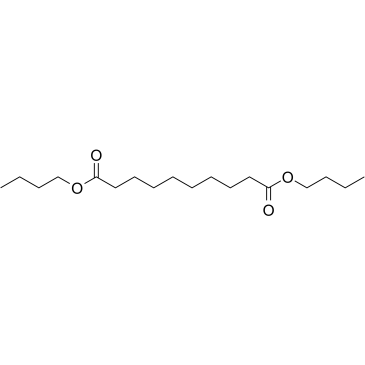Dibutyl sebacate

Dibutyl sebacate structure
|
Common Name | Dibutyl sebacate | ||
|---|---|---|---|---|
| CAS Number | 109-43-3 | Molecular Weight | 314.460 | |
| Density | 0.9±0.1 g/cm3 | Boiling Point | 351.3±10.0 °C at 760 mmHg | |
| Molecular Formula | C18H34O4 | Melting Point | 205 °C (dec.)(lit.) | |
| MSDS | Chinese USA | Flash Point | 157.5±17.4 °C | |
| Symbol |

GHS07 |
Signal Word | Warning | |
|
A novel approach for honey pollen profile assessment using an electronic tongue and chemometric tools.
Anal. Chim. Acta 900 , 36-45, (2015) Nowadays the main honey producing countries require accurate labeling of honey before commercialization, including floral classification. Traditionally, this classification is made by melissopalynology analysis, an accurate but time-consuming task requiring l... |
|
|
Formulation considerations in the design of topical, polymeric film-forming systems for sustained drug delivery to the skin.
Eur. J. Pharm. Biopharm. 91 , 9-15, (2015) Polymeric film-forming systems (FFSs) are potential drug delivery systems for topical application to the skin. The FFSs form thin and transparent polymeric films in situ upon solvent evaporation. Their application convenience and cosmetic attributes, superior... |
|
|
In-line NIR monitoring of key characteristics of enteric coated pellets.
Eur. J. Pharm. Biopharm. 88(3) , 847-55, (2015) We describe the development of an in-line monitoring approach for the fluid-bed drying and coating steps for the production of enteric coated pellets by NIR. Our results show that key pellet characteristics can be monitored in-line. Likewise, the finished pro... |
|
|
Calendering as a direct shaping tool for the continuous production of fixed-dose combination products via co-extrusion.
Eur. J. Pharm. Biopharm. 96 , 125-31, (2015) In this study calendering is used as a downstream technique to shape monolithic co-extruded fixed-dose combination products in a continuous way. Co-extrudates with a metoprolol tartrate-loaded sustained-release core and a hydrochlorothiazide-loaded immediate-... |
|
|
In situ forming implants for periodontitis treatment with improved adhesive properties.
Eur. J. Pharm. Biopharm. 88(2) , 342-50, (2014) Novel in situ forming implants are presented showing a promising potential to overcome one of the major practical hurdles associated with local periodontitis treatment: limited adhesion to the surrounding tissue, resulting in accidental expulsion of at least ... |
|
|
Cytocompatibility of new phthalate ester-free tissue conditioners in vitro.
Dent. Mater. J. 21(2) , 118-32, (2002) The estrogenic activity of phthalate esters for dental use as plasticizers was concerned. To study the feasibility of candidate chemicals for phthalate tissue conditioners, three candidate plasticizers, di-n-butyl sebacate, acetyl tributyl citrate and tri-n-b... |
|
|
[Examination of sex-hormonal activity of some additives for PVDC film].
Shokuhin Eiseigaku Zasshi 44(5) , 227-33, (2003) Stabilizers (epoxidized linseed oil and epoxidized soybean oil) and plasticizers (acetyl tributyl citrate, diacetyl monolauryl glyceride and dibutyl sebacate) commonly used in polyvinylidene chloride (PVDC) films and extracts of such films were investigated f... |
|
|
Drug release from diffusion pellets coated with the aqueous ethyl cellulose dispersion Aquacoat ECD-30 and 20% dibutyl sebacate as plasticizer: partition mechanism and pore diffusion.
Eur. J. Pharm. Biopharm. 47(1) , 27-32, (1999) The release of the hydrophilic etofylline and the lipophilic propyphenazone (octanol/water partition coefficient PC = 0.35 and 119, respectively) from diffusion pellets coated with the aqueous ethyl cellulose dispersion Aquacoat ECD-30 and 20% dibutyl sebacat... |
|
|
Temporary restorative resins using non-phthalate ester plasticizers.
J. Dent. 33(7) , 577-83, (2005) This study examined temporary restorative resins that use non-phthalate ester plasticizers.Three non-phthalate plasticizers were tested: tri-ethyl citrate (TEC), tri-butyl citrate (TBC), and di-butyl sebacate (DBS). The experimental resins were compared with ... |
|
|
Novel type of in situ extraction: Use of solvent containing microcapsules for the bioconversion of 2-phenylethanol from L-phenylalanine by Saccharomyces cerevisiae.
Biotechnol. Bioeng. 83(4) , 376-85, (2003) A novel in situ product removal (ISPR) method that uses microcapsules to extract inhibitory products from the reaction suspension is introduced into fermentation technology. More specifically, L-phenylalanine (L-Phe) was transformed by Saccharomyces cerevisia... |